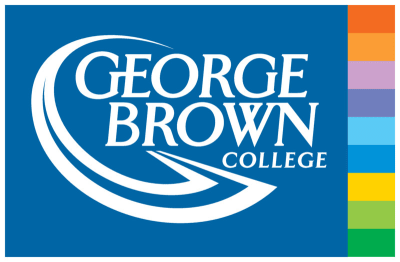
Honors Bachelor of Brand Design
George Brown College

Key Information
Campus location
Toronto, Canada
Languages
English
Study format
On-Campus
Duration
4 years
Pace
Full time
Tuition fees
CAD 20,019 / per year *
Application deadline
Request info
Earliest start date
Request info
* for international students. All fees are subject to change, without notice
Introduction
The Honours Bachelor of Brand Design is a four-year degree program that responds to the rapidly changing world of graphic design by preparing you to be forward-looking brand designers with strengths in collaboration, research, critical and strategic thinking, technical design execution, and brand storytelling. It is built on multidisciplinary pillars of research, critical thinking, strategic brand development, technical design execution, and brand storytelling.
Brands are more than logos or sales tactics, they are carefully developed relationships between the brand makers and audiences – a brand is a promise to follow through on a purpose and a set of values that taken together express how someone perceives an organization or product. The Honours Bachelor of Brand Design degree is an opportunity to build a knowledgeable creative community of collaborators and strategic designers who are able to bridge business strategy, technology, and the design world in order to produce innovative brand experiences.
As a student of the Honours Bachelor of Brand Design degree program, you will develop the analytical and technical skills to:
- Communicate and evolve the brand through the design of visual and physical, online and offline identities and experiences.
- Research to create and tailor designs that work across different touchpoints, generating dynamic, responsive, multi-sensory, and personalized brand experiences for customers.
- Write, visualize and translate the brand story across these touchpoints and engage long-term with the emotions of audiences.
- Collaborate toward creative innovation with multidisciplinary teams.
This program responds to the dynamic and growing field of design, training you to:
- Create streamlined brand messaging across numerous mediums and touchpoints that engage audiences.
- Understand new technology and be able to work across the old and new channels.
- Have strong writing skills and adapt to different situations, audiences, and genres.
- Be flexible in that they are able to adapt to changing work and work environments (multiple sectors, services, and products).
- Work collaboratively and bridge business and creative roles by understanding the culture, processes, and language of the branding business.
- Utilize diverse and quantifiable research methodologies in the design process.
- Offer a diverse and customizable range of services to clients, particularly niche services (e.g., video and animation).
- Have the ability to compete on tender: put together a professional sales pitch while offering a competitive price.
Why study Brand Design at George Brown College?
The School of Design at George Brown has an established reputation for design education that focuses on imagination, hones critical thinking skills, and engages with the latest technologies. Our faculty bring a combination of professional experience and advanced education to offer course content that is always evolving and reflective of trends in industry and academia.
The School of Design resides in a new 103,000-square-foot facility in the Daniels Waterfront – City of the Arts development. This state-of-the-art building supports academic programs and industry projects with features such as:
- virtual and augmented reality lab
- usability and testing lab
- Future Ways of Living lab
- peer tutor lab
- digital sandbox
- incubators
- prototyping and workshop spaces
- design and innovation showcase spaces
Our facilities and computer labs include the latest hardware and software and are complemented by a curriculum that reflects changing industry demands.
Your Field Education Options
Students must complete a 420-hour paid co-op work term in the spring/summer period between the third and fourth year.
Students have the opportunity to complete this co-op domestically and/or internationally, as opportunities arise. The majority of co-op work terms are completed in the Greater Toronto Area, where the design sector is robust and the majority of interaction jobs are located.
The School of Design Field Placement team works with many notable training partners, including agencies such as Publicis, K9 Strategy + Design, Trevor/Peter, and Relish Interactive; larger, well-known brands such as Nelvana (Corus Entertainment), Rogers Media, Mozilla, Crayola, and PUR Gum; and a variety of industry-relevant arts and design institutions, including the Toronto International Film Festival (TIFF), the Association of Registered Graphic Designers (RGD) and Applied Arts.
The work term allows students to apply the skills, abilities, and knowledge they've acquired in the program in a workplace environment or through an appropriate interaction design research project or initiative. Students gain valuable experience and the opportunity to reflect on the application of previous learning. A faculty member evaluates the student based on feedback provided by the employer.
Students will develop a digital portfolio demonstrating artifacts completed during the co-op work term.
Admissions
Scholarships and Funding
Scholarships for international students at George Brown College are generally in-program awards based on students’ academic performance (and other criteria) at George Brown College after the beginning of the academic program.
Curriculum
Required Courses
| Semester 1 | Semester 2 | Semester 3 |
|
|
|
| Semester 4 | Semester 5 | Semester 6 |
|
|
|
| Summer | Semester 7 | Semester 8 |
|
|
|
Program Outcome
The graduate demonstrates the ability to:
- Use ideation techniques to generate innovative design solutions that respond to a creative brief.
- Participate in a collaborative brand-building project to produce an outcome that meets the needs of the client.
- Incorporate interdisciplinary theoretical approaches in the planning, production, and critique of design and strategy work.
- Plan, conduct, and apply research in order to contextualize and make an informed design.
- Assess the social, environmental, and economic impact of the design solution in order to prioritize sustainability issues in design practice.
- Use the fundamental principles of branding to address the needs of the brand design and strategy for clients of various scales.
- Design solutions in support of a brand strategy.
- Communicate information, arguments, creative ideas, and brand stories persuasively, to a range of audiences, using a variety of verbal, visual, and written communication techniques.
- Utilize professional practices and knowledge of the business of branding in all design and strategy work.
Career Opportunities
Your Career
Graduates will be trained for work that spans several occupational areas in advertising, marketing, and public relations, as graphic designers and illustrators, content writers and web producers, communications specialists, marketing researchers, and business and strategy consultants.
Career Options
Graduates of this program will have acquired the skills necessary to be employed in design, branding, and digital media studios, creative labs, in-house design, and digital departments within larger corporations across sectors, or to work independently or in a start-up.
This program prepares graduates for positions such as:
- brand designer
- digital designer
- user interface designer
- design strategist
- community manager
- graphic designer
- design researcher
- storyteller/content writer
- communications officer
- marketing researcher
- communication designer
- content strategist
Educational Pathways
If you are a George Brown College student who has completed the second or third year of the Graphic Design Advanced Diploma (G102) with a grade point average of 3.2 (75%) or higher, you may be eligible to enter a degree completion pathway to this program. For more information, contact your program coordinator.
Future Study Options
Graduates of the Honours Bachelor of Brand Design program may qualify to pursue further graduate studies in relevant program areas. Students should contact universities directly to explore graduate school opportunities.
Graduates of the degree will be prepared for graduate studies in branding, design and communication fields.